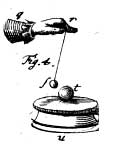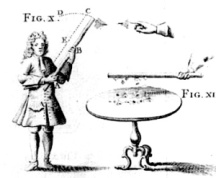
Over the span of a number of articles Simon Schaffer wrote in the mid-to-late 1990s, he forcefully argued for the existence and importance of a particular historical phenomenon, prevalent in the 18th and 19th centuries. This was natural philosophers’ and projectors’ use of mechanical devices to attempt to gain intellectual authority over others’ ideas and labor, which was to be accomplished by making that authority appear to emanate from the machines themselves, rather than from the deft manipulation of the social settings in which those machines were deployed. Although Schaffer only used it a couple of times, I am using his term “machine philosophy” to refer to his conception of this strategy. I will further explain his arguments concerning machine philosophy—and, of course, offer my opinion of those arguments—in future posts.
I had originally thought I was going to discuss Schaffer’s “Experimenters’ Techniques, Dyers’ Hands, and the Electric Planetarium,” Isis 88 (1997): 456-483 (free) in the “Schaffer on Machine Philosophy” series. However, once I really got into the piece, I realized that he does not regard the “electric planetarium” experiment (above left) in the same vein as he regards, say, Atwood’s Machine. In Schaffer’s historical schematic, the electric planetarium would not have been part of the machine philosophy rising at that time explicitly because what authority it commanded was held to reside in the embodied skill and social integrity of the experimenter.
Schaffer’s most concrete accomplishment in “Experimenters’ Techniques” is to reassemble the history of the electric planetarium experiment—a lesser-known episode in the history of electrical experimentation. It does not appear, for example, in John Heilbron’s canonical Electricity in the 17th and 18th Centuries.
The experiment was first performed by Stephen Gray (1666-1736), a Canterbury dyer who, in his later years, became widely known for his pathbreaking experiments with electricity. In a letter Gray sent the week before his death to his patron and collaborator, Granville Wheler (1701-1770), he described an experiment in which a small suspended electrified object was found to revolve, in circles or ellipses, about a larger repulsive object placed on a cake of electrified resin, and always in the same direction as the planets orbit the sun.
The day before Gray’s death,* the secretary of the Royal Society, Cromwell Mortimer (c1693-1752), visited him. Mortimer obtained additional details of the experiment, which he quickly published. He also learned of Gray’s hope that his experiments would “astonish the World with a new Sort of Planetarium never before thought of, and that from these Experiments might be established a certain Theory for accounting for the Motions of the Grand Planetarium of the Universe.”
 Electrical experiments, illustrated in J. T. Desaguliers, Course of Experimental Philosophy, Vol. 1 (1734)
Electrical experiments, illustrated in J. T. Desaguliers, Course of Experimental Philosophy, Vol. 1 (1734)
Subsequently, Wheler managed to replicate the experiment successfully, and he, too, suggested it indicated that celestial motion might be the product of a balance of attractive and repulsive forces. Meanwhile, others at the Royal Society in London, and Charles Dufay (1698-1739) in Paris, could not achieve the effect of revolution for themselves. This failure, however, was not necessarily fatal. Electrical experiments were notoriously capricious, with results varying greatly depending upon the materials and technique used, and the conditions under which the experiments were performed. Oftentimes even the experimenter’s own body was integral to the experimental procedure. Gray, in particular, had been known and respected for his special “knack” with electricity.
Thus, trials with the electrical planetarium continued for two years after Gray’s initial report. As failures to replicate compounded, the procedures and conditions that Wheler deemed necessary for experimental success became more elaborate. Moreover, Wheler himself could not replicate the phenomenon when his body was not involved. As he wrote to Dufay in late 1737, he delayed his own publication on the experiment because he could not get it to work “when the Pendulous Body has been supported by an undoubtedly fixed Point” (478).
This difficulty weighed on Wheler, until finally he undertook a more systematic study of his arm and hand’s role in the experiment. At last, in early 1738, he became convinced that, unbeknownst to Gray and himself, “a Desire of producing a Motion from West to East, was the secret Cause that determined the pendulous Body to that Direction, by some Impression from Mr. Gray’s Hand, as well as my own…” Thus, the motion was “to be ascribed to the Hand that holds it, and not solely to the Nature of the electric Effluvia, or the Figure of the central Body”.
Reporting his disappointing conclusion to the Royal Society and Dufay, he allowed that the experiment could have no direct bearing on astronomical knowledge, but suggested that “it may not be improper for Astronomers to consider whether or not a Medium with this property, that all bodies immersed in it, are repulsive of one another, ought not to be joined with Gravity to explain the heavenly Phaenomena; especially since the Phaenomena of Fire, and our electric Effluvia, have a great Affinity to each other…”
In itself, Schaffer’s reconstruction of the story, which extensively employs private correspondence, would have made for one of those nice, brief, to-the-point articles they have in Notes and Records of the Royal Society. Schaffer, however, aims for bigger game here. We will look at his larger argument in a follow-up post.
—
*Various online sources report February 7th as the date of Gray’s death. However, Mortimer’s letter clearly indicates February 15th to be the date.